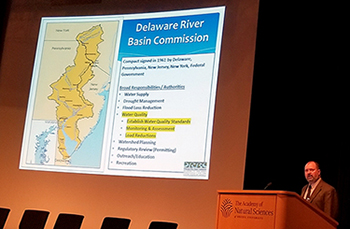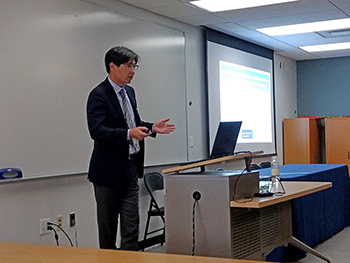Delaware • New Jersey • Pennsylvania
New York • United States of America
 |
 |
| DRBC's John Yagecic, P.E., (above) and Dr. Namsoo Suk present at the 2018 Delaware Watershed Research Conference. Photos by DRBC. |
A couple of DRBC's research projects that are currently underway as part of the commission's Designated Use Study of the Delaware Estuary were featured recently at the Academy of Natural Sciences (ANS) of Drexel University's Delaware Watershed Research Conference in Philadelphia, Pa.
The conference brought together students, watershed scientists, and stakeholders to foster collaboration and discuss ongoing research efforts in the Delaware River Basin.
DRBC Manager of Water Quality Assessment John Yagecic, P.E., presented on an engineering evaluation and cost estimation project for Delaware Estuary wastewater treatment plants.
DRBC Director of Science and Water Quality Management Dr. Namsoo Suk presented on the development of a hydrodynamic and water quality model for the Delaware Estuary that will be used to allocate nutrient loadings from point and non-point sources in order to achieve higher levels of dissolved oxygen.
Modeling Eutrophication Processes in the Delaware Estuary to Link Watershed Efforts to Control Nutrient Impacts (pdf 1.6 MB)
Through the DRBC, the commission's Designated Use Study for the Delaware Estuary is bringing together the basin states and federal partners to determine the water quality criteria necessary to support higher aquatic life uses for the estuary and the nutrient load reductions from point and non-point sources needed to attain supportive dissolved oxygen concentrations. It also affirms the important goal of continued water quality improvement in this stretch of river.
Copyright © Delaware River Basin Commission,
P.O. Box 7360, West Trenton, NJ 08628-0360
Phone (609)883-9500; Fax (609)883-9522
Thanks to NJ for hosting the DRBC website